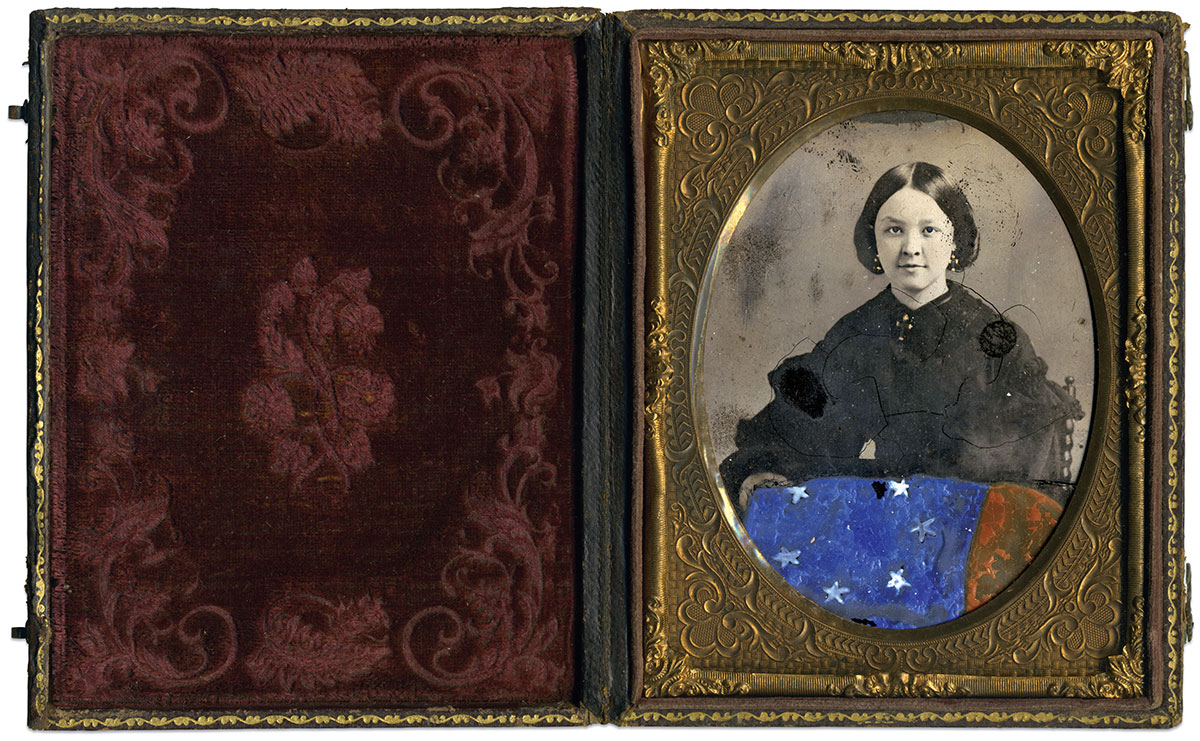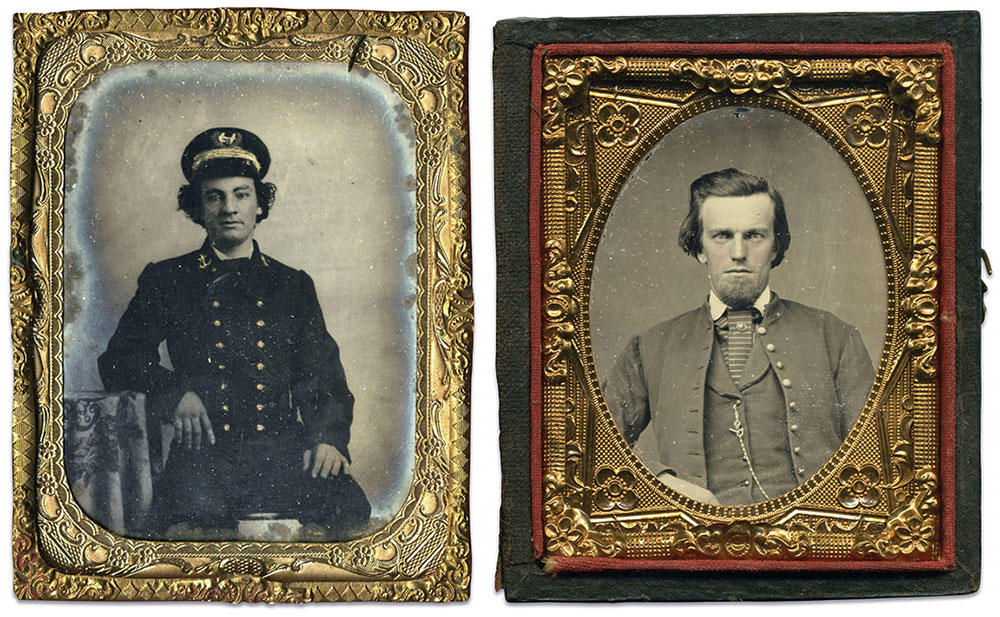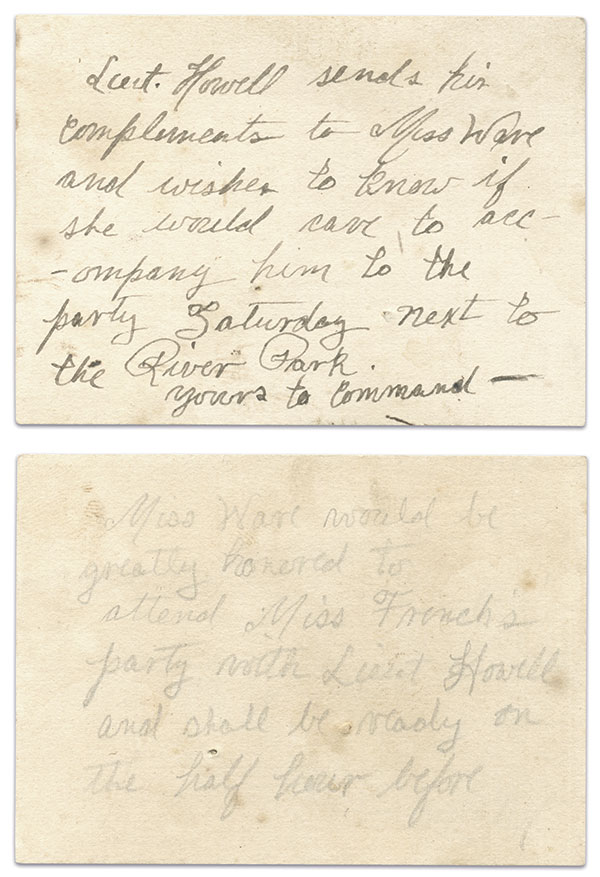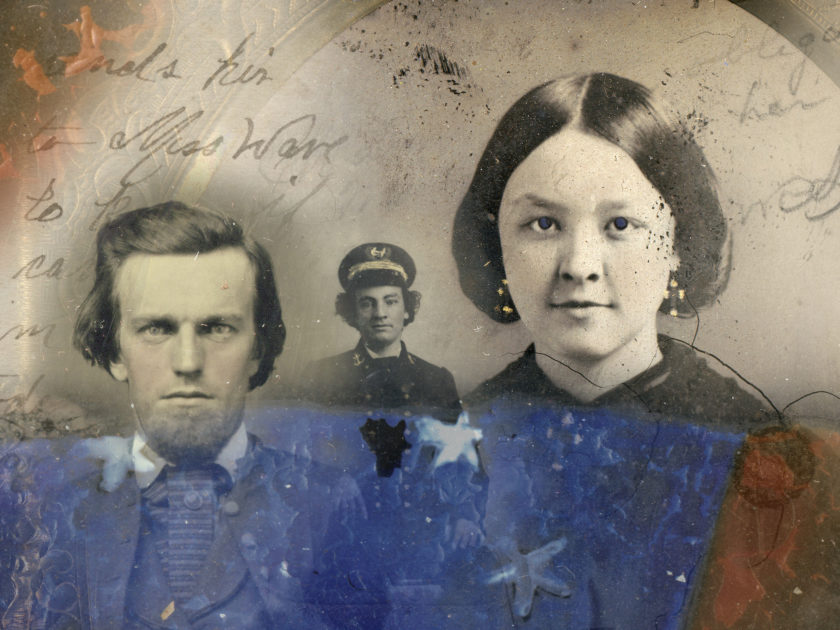By Doug York and Ronald S. Coddington
Long before Vicksburg became ground zero in the federal campaign to control the Mississippi, the city thrived as an important transportation gateway. A seemingly endless procession of steamboats laden with goods chugged to and from its piers, leaving trails of smoke puffing from iron stacks. High above the river and sprawled across rugged cliffs, streets buzzed with all the noise and bustle of daily business.
The social life of the city was as vibrant as its commercial enterprises, and it intensified during the heady days following secession. Gala parties celebrated the birth of the Confederacy and the volunteer Southrons called to arms in defense of the new nation.
One such event in the spring of 1861 provided the setting for a romance between an Alabama belle and a Marine lieutenant with family and friends in high places.
The belle, Virginia Frances Ware, was a 16-year-old beauty born and raised in Alabama. The youngest of five children, she enjoyed a privileged life. Her father, William Ware, a Georgian and the son of Irish immigrants, had moved his family to Alabama around 1842, a few years before Virginia’s birth. He established a plantation in Perry County, part of a 650-mile-stretch of fertile territory known as the Canebrake region. Well-suited for largescale cotton cultivation, landowners here referred to themselves as “Canebrake Planters,” a term of pride that embodied their wealth, power, dignity and honor. A sizeable slave population toiled in their fields, including 68 men, women and children of color owned by Ware.

In 1856, then 11-year-old Virginia suffered tragedy when her mother died. At some point afterwards, she journeyed 200 miles west to Vicksburg and became a houseguest of the Hicks family. Her connection to the Hicks and motivation for the visit is unclear. Martha M. Cowan Hicks, the matriarch of the family, was a widow in her early 40s. The death of her prominent physician husband some years earlier left her to raise four sons, with the assistance of three slaves.
Martha’s second eldest, William Anderson Hicks, held the rank of midshipman at the U.S. Naval Academy when Mississippi legislators passed the state’s Ordinance of Secession on Jan. 9, 1861. About two months later, as his senior year wound down, he resigned his U.S. commission in protest to the incoming administration of President Abraham Lincoln. According the news reports, young Hicks headed to Montgomery to offer his services to the Confederacy. By early April, he was at home awaiting orders for his first assignment in gray.
Also in Vicksburg was a former U.S. Marine lieutenant and native Mississippian. Becket Kempe Howell, a 20-year-old born in Natchez, had recently resigned his commission for the same rank in the Confederate Marines. He was connected to the highest level of the Southern government. First lady Varina Davis was his sister. President Jefferson Davis served something of a role model for Howell, having helped him with his military career.

Howell likely knew Hicks, considering their Mississippi ties and the small size of the peacetime U.S. navy. Hicks probably also introduced Howell to his houseguest, Virginia. There can be no question that they met. In Virginia’s surviving papers, an invitation written by Howell to Virginia, in care of Martha Hicks, reads: “Lieut. Howell sends his compliments to Miss Ware and wishes to know if she would care to accompany him to the party Saturday next to the River Park. Yours to Command—.”

Command she did. Virginia wrote her answer on the back of the invitation. “Miss Ware would be greatly honored to attend Miss French’s party with Lieut. Howell and shall be ready on the half hour before.” Though the event date is not included, evidence suggests it occurred in April 1861.
The party appears to have been a success for the pair. A month later, on May 3, Howell gave Virginia a lock of his hair, a sure indication of a courtship. Virginia placed the lock in an envelope and annotated it in pencil.
That same day, Howell left for New Orleans. He had orders to report for duty aboard the bark-rigged screw steamer Sumter, the Confederacy’s first raider. He joined a crew hand-picked by the vessel’s commander, former U.S. navy officer Raphael Semmes. According to a fellow officer, Howell was “a big-hearted, generous fellow, every ready to please a shipmate. Semmes’s affection for him was marked.”
Howell likely left Vicksburg with Hicks, also selected by Semmes to be part of the crew. Hicks ranked as midshipman. All three men were aboard the Sumter on June 30, 1861, when the cruiser steamed into the Gulf of Mexico and eluded the Union sloop-of-war Brooklyn, after a dramatic four-hour chase. The Richmond Daily Dispatch reported that the Sumter had run “the paper blockade of Lincoln-Abolition war steamers off the mouth of the Mississippi. As she has now made a good offing, and is far out on the ocean wave, we hope soon to hear of some dashing exploits in the way of captures.”
And so began a six-month reign of terror in the Atlantic Ocean and Caribbean Sea, during which 18 merchant vessels fell prey to the Sumter.

Towards the end of the Sumter’s run, on Jan. 7, 1862, Virginia sent Semmes a pair of pants as a gift. Though the exact circumstances behind the gift are not known, a card sent by Virginia suggests that Semmes expected them. “Miss Ware’s compliments to Capt. Semmes, and sends the pantaloons, hoping that they will please him.” One can easily imagine in a lost exchange of letters, which Howell wrote to Virginia, that Semmes needed a good pair of trousers, and she replied with a promise to make him a pair. Or perhaps, Semmes complained about ill-fitting trousers, and Howell offered to have Virginia make him a custom pair. It is also not unusual that Howell and Semmes would chat about personal matters, as the two were on friendly terms.
Whatever the reason, Semmes acknowledged the receipt of the pants on the back of the same card with an inscription to Virginia with thanks for her kindness.
If Virginia sewed the pants, did she also use needle and thread to stitch together the Confederate First National flag that she posed with in the portrait pictured here? Did she present the flag to Semmes or Howell? Perhaps other surviving papers will surface at some future date to shed light on the origins and fate of this Southern banner, and the other aspects of her story.
Semmes would go on to command the raider Alabama and capture another 65 prize vessels. His two-year rampage on the open seas ended famously on June 19, 1864, when he was finally brought to bay, and the Alabama sunk, by Union Capt. John A. Winslow and the crew of the Kearsarge off the port of Cherbourg, France. Semmes returned to the Confederacy, and, during the waning days of the war, commanded the Naval Brigade with the temporary rank of brigadier general. He surrendered to Maj. Gen. William T. Sherman on April 26, 1865, and was paroled soon afterwards. He lived until 1877.
Howell followed Semmes to the Alabama and participated in the fight against the Kearsarge. When it became clear that the Alabama was lost, Semmes struck the colors and ordered Howell to take the last intact small boat and hail the Kearsarge to assist in the rescue of survivors. Capt. Winslow agreed to help, and permitted Howell and his crew to participate in the effort. Howell did so, and delivered a boatload of his injured crewmates to the Kearsarge before making his way to the British yacht Deerhound, where Semmes and about 40 other survivors sought refuge.
Howell eventually made his way back to America by way of Canada, and struggled to rebuild his life in the new South. In 1882, brother-in-law Jefferson Davis appointed him overseer of Brierfield Plantation in Mississippi. Howell soon fell ill with swamp fever and died before the end of the year.
Hicks’s stint on the Sumter was brief. On July 27, 1861, after less than two months aboard ship, Semmes placed him in charge of a five-men crew to dispose of the captured prize vessel Joseph Maxwell. Two weeks later off the coast of Cuba, Hicks spied what he believed a Union warship. He grounded his vessel on a reef and escaped with his crew. The approaching ship was actually a Spanish steamer. The Spaniards towed the Joseph Maxwell off the reef and took possession of it. Stranded in Cuba, Hicks sought a way home via a British blockade-runner, the Ezilda, but was captured on Sept. 30, 1861. He eventually gained his release and returned to Vicksburg, where he received a promotion to lieutenant and assignment to the gunboat Arkansas. He died April 29, 1862, aboard the steamer Capitol at Yazoo City, Miss. He was 20 years old. The circumstances of his death are not known.
Virginia barely survived the war. She died in 1866 at age 21 of unknown causes. Her remains were buried in Perry County. She never married.
Special thanks to Matt Hagans of Museum Investments.
Note: This story was pieced together from surviving documents and photographs from the Virginia Frances Ware Papers, along with research from genealogical records and other primary sources.
References: Virginia Frances Ware Papers, Doug York Collection; Davis, Billingsley Family in America; 1850, 1860 Slave Schedules; 1850, 1860 U.S. Census; “Canebrake Plantations,” National Register Historic Places Multiple Property Documentation Form, U.S. Department of the Interior; Vicksburg Whig, March 20 and April 3, 1861; Arthur Sinclair, Two Years on the Alabama; David Sullivan, “A Marine on the Raider Alabama; Lt. Becket Kempe Howell, C.S.M.C.,” Military Images (January-February 1991); Daily Dispatch (Richmond, Va.), July 10, 1861; Raphael Semmes, Cruise of the Alabama and the Sumter; Raphael Semmes, Memoirs of Service Afloat; Official Records of the War of the Rebellion; Federal Cases Comprising Cases Argued and Determined in the Circuit and District Courts of the United States, Book 8; N.C. Civil War Sailors Project.
Doug York is a 30-year collector of Civil War items who has specialized in photography the last 20 years. He is also Editor of Civil War Faces on Facebook.
Ronald S. Coddington is Editor and Publisher of MI.
SPREAD THE WORD: We encourage you to share this story on social media and elsewhere to educate and raise awareness. If you wish to use any image on this page for another purpose, please request permission.
LEARN MORE about Military Images, America’s only magazine dedicated to showcasing, interpreting and preserving Civil War portrait photography.
VISIT OUR STORE to subscribe, renew a subscription, and more.

